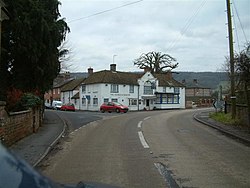Hurstbourne Tarrant
| Hurstbourne Tarrant | |
| Hampshire | |
|---|---|
 The George and Dragon, Hurstbourne Tarrant | |
| Location | |
| Grid reference: | SU384533 |
| Location: | 51°16’39"N, 1°27’5"W |
| Data | |
| Population: | 864 (2011) |
| Post town: | Andover |
| Postcode: | SP11 |
| Dialling code: | 01264 |
| Local Government | |
| Council: | Test Valley |
| Parliamentary constituency: |
North West Hampshire |
Hurstbourne Tarrant is a village n Hampshire, in the north of the county in the valley of the River Test. It sits in a little valley of the River Swift, which becomes the Bourne Rivulet, where the river is bridged by the A343 road between Newbury and Andover.
The 'Tarrant' part of the name originates from 1226, when the village was given to the Cistercian Tarrant nunnery. The civil parish includes the village of Ibthorpe.
During the Second World War, Hurstbourne Tarrant was a 'Starfish site'; a decoy site for RAF Andover, the headquarters of RAF Maintenance Command. This was one of four airfields in Hampshire to be given a decoy site in 1940, to deceive enemy aircraft into attacking a spurious target. The decoy site at Hurstbourne Tarrant was a type 'K' decoy site with fake aircraft and buildings. From September 1940, fake machine gun posts were added to Hurstbourne Tarrant.
The famous American Victorian/Edwardian artist Anna Lea Merritt lived in the village for many years.
William Cobbett declared Hurstbourne Tarrent and its location as worth going miles to see with beauty at every turn.[1] He referred to it in his book Rural Rides (1830) as 'Uphusband'.
Hurstbourne House
Hurstbourne House is a grade II listed late 17th-century country house at the edge of the village. It was renovated in the late 18th and early 19th centuries. It is home to the Sharpe family. The original central range was built in two storeys, and has 19th century three-storey cross wings at each end. The walls are stucco rendered and the roof tiled. The frontage has three bays, the central one recessed.[2]
Outside links
| ("Wikimedia Commons" has material about Hurstbourne Tarrant) |
References
- ↑ Mee, Arthur: The King's England: Hampshire with the Isle of Wight (Hodder & Stoughton)
- ↑ National Heritage List 1093369: Hurstbourne House (Grade II listing)
